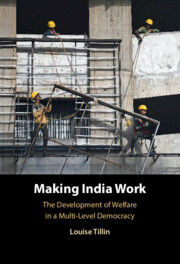Book contents
- Making India Work
- Making India Work
- Copyright page
- Dedication
- Contents
- Illustrations
- Acknowledgments
- Abbreviations
- 1 Introduction
- 2 Origins, Expansion, and Reform
- Part I Building a National Economy: Regulating Internal Competition
- Part II Putting India to Work
- Part III Liberalisation and Welfare in a Multi-level Democracy
- 7 Liberalisation and the ‘Social Safety Net’
- 8 Welfare, Rights, and the Market in the Post-Congress Polity, 1998–2014
- 9 Conclusion
- Bibliography
- Index
7 - Liberalisation and the ‘Social Safety Net’
from Part III - Liberalisation and Welfare in a Multi-level Democracy
Published online by Cambridge University Press: 13 February 2025
- Making India Work
- Making India Work
- Copyright page
- Dedication
- Contents
- Illustrations
- Acknowledgments
- Abbreviations
- 1 Introduction
- 2 Origins, Expansion, and Reform
- Part I Building a National Economy: Regulating Internal Competition
- Part II Putting India to Work
- Part III Liberalisation and Welfare in a Multi-level Democracy
- 7 Liberalisation and the ‘Social Safety Net’
- 8 Welfare, Rights, and the Market in the Post-Congress Polity, 1998–2014
- 9 Conclusion
- Bibliography
- Index
Summary
The fiscal burden of government interventions in the rural economy had created growth but led the economy to the brink of crisis. When India implemented full-blown economic reforms in 1991, many assumed these would sideline social policy. This chapter shows that liberalisation pushed social policy up the political agenda. Efforts to enable an ‘exit policy’ for ailing firms by loosening restrictions on retrenchment under chapter VB of the Industrial Disputes Act failed due to opposition from organised labour. The controversy created an opening to strengthen - or at least maintain - existing ‘social safety nets’ to support the project of economic transformation. The Government of India used a World Bank loan initially intended to support the ‘exit policy’ to maintain the rural social policies that had been introduced or expanded in the 1980s, as part of what Finance Minister Manmohan Singh described as macroeconomic adjustment with a ‘human face’. The chapter shows that political regionalisation and the intensification of multi-level electoral competition in the 1990s encouraged subnational social policy innovation and worked against the retrenchment of existing social policies.
Keywords
- Type
- Chapter
- Information
- Making India Work , pp. 151 - 172Publisher: Cambridge University PressPrint publication year: 2025

